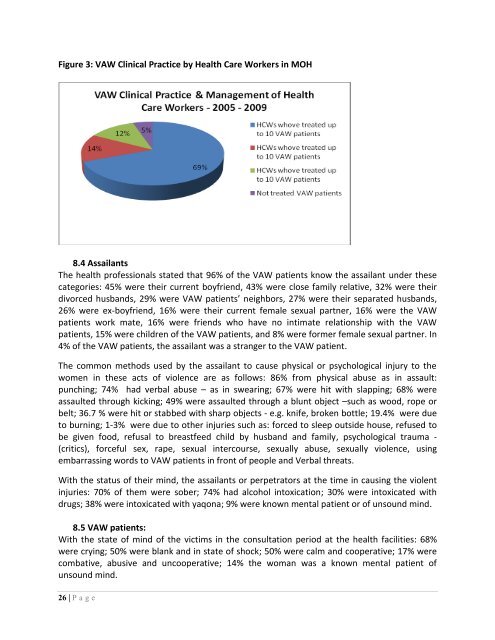Project Report â Fiji 2010 - Pacific Health Voices
Project Report â Fiji 2010 - Pacific Health Voices
Project Report â Fiji 2010 - Pacific Health Voices
You also want an ePaper? Increase the reach of your titles
YUMPU automatically turns print PDFs into web optimized ePapers that Google loves.
Figure 3: VAW Clinical Practice by <strong>Health</strong> Care Workers in MOH<br />
8.4 Assailants<br />
The health professionals stated that 96% of the VAW patients know the assailant under these<br />
categories: 45% were their current boyfriend, 43% were close family relative, 32% were their<br />
divorced husbands, 29% were VAW patients’ neighbors, 27% were their separated husbands,<br />
26% were ex-boyfriend, 16% were their current female sexual partner, 16% were the VAW<br />
patients work mate, 16% were friends who have no intimate relationship with the VAW<br />
patients, 15% were children of the VAW patients, and 8% were former female sexual partner. In<br />
4% of the VAW patients, the assailant was a stranger to the VAW patient.<br />
The common methods used by the assailant to cause physical or psychological injury to the<br />
women in these acts of violence are as follows: 86% from physical abuse as in assault:<br />
punching; 74% had verbal abuse – as in swearing; 67% were hit with slapping; 68% were<br />
assaulted through kicking; 49% were assaulted through a blunt object –such as wood, rope or<br />
belt; 36.7 % were hit or stabbed with sharp objects - e.g. knife, broken bottle; 19.4% were due<br />
to burning; 1-3% were due to other injuries such as: forced to sleep outside house, refused to<br />
be given food, refusal to breastfeed child by husband and family, psychological trauma -<br />
(critics), forceful sex, rape, sexual intercourse, sexually abuse, sexually violence, using<br />
embarrassing words to VAW patients in front of people and Verbal threats.<br />
With the status of their mind, the assailants or perpetrators at the time in causing the violent<br />
injuries: 70% of them were sober; 74% had alcohol intoxication; 30% were intoxicated with<br />
drugs; 38% were intoxicated with yaqona; 9% were known mental patient or of unsound mind.<br />
8.5 VAW patients:<br />
With the state of mind of the victims in the consultation period at the health facilities: 68%<br />
were crying; 50% were blank and in state of shock; 50% were calm and cooperative; 17% were<br />
combative, abusive and uncooperative; 14% the woman was a known mental patient of<br />
unsound mind.<br />
26 | P a g e
















